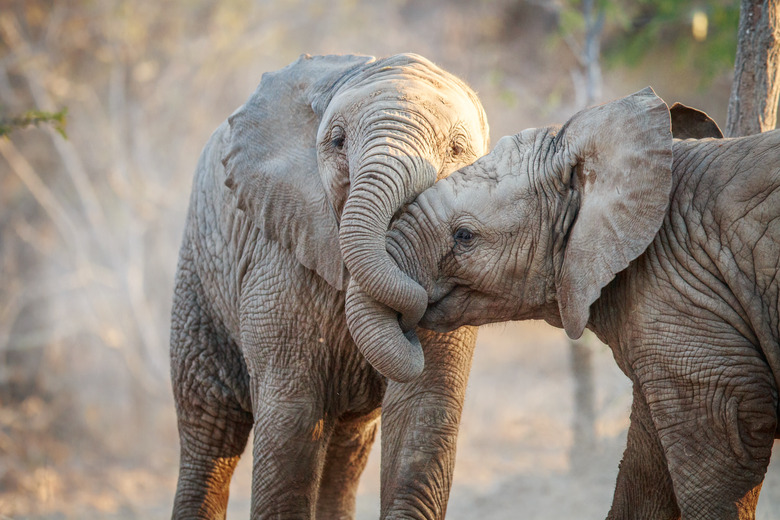How Do Elephants Give Birth?
The male elephant is referred to as a bull, the female as a cow and the baby as a calf. The male elephant will begin mating between the ages of 10 and 14 years, while the female elephant will begin to mate between the ages of 12 and 15 years. After mating, the bull and cow elephants do not stay together. The bull elephant usually mates with several different females.
TL;DR (Too Long; Didn't Read)
Female elephants might give birth every five years, and continue to mate until about the age of 50. Her pregnancy lasts up to 23 months, and the calf weighs between 200 to 320 pounds. Wild elephants normally give birth at night. It is believed this is to provide them with an undisturbed environment. Labor lasts several days. The elephant slowly expels the amniotic sac, which contains the calf, and may burst during labor. If it does not break, it cushions the calf's fall of 2 to three feet to the ground and bursts upon impact. The mother sniffs and blows on the calf, and then pull it toward her. Within an hour the calf can stand, and within a few hours it can walk. It nurses for four years, and is dependent on the mother and the herd for six years.
Elephants’ Unique Pregnancy
Elephants' Unique Pregnancy
The female elephant normally gives birth to a single calf, unless she has twins. Female elephants might give birth every five years, and continue to mate until about the age of 50. The female elephant's pregnancy will last up to 23 months, longer than many other animals. When she does give birth, the calf can weigh anywhere from 200 to 320 pounds.
Female Elephants' Labor
Female Elephants' Labor
The labor can last for several days, beginning with labor pains. The female elephant will lose her mucous plug, and contractions increase as the labor continues. Wild elephants normally give birth at night. It is believed this is to provide them with an undisturbed environment. A female in labor has been known to make attempts to interrupt the birth, if it is occurring during the day or early dawn.
Birth of the Calf
Birth of the Calf
The amniotic bladder may push out before the calf, appearing like a balloon-like matter. The elephant may attempt to rub off the protruding bladder. The calf passes through the birth canal, and the mother separates the amniotic bladder from the newborn. The mother sniffs and blows on the calf. Once she accepts her calf, the mother will pull it towards her.
Standing and Feeding the Calf
Standing and Feeding the Calf
Within an hour after arriving, the newborn calf is able to stand. A few hours later, the newborn elephant is walking. After learning to stand on its own four feet, the calf's next goal is to find its mother's breast and begin nursing. Calves nurse for about four years, with mother's milk being its mainstay for the first six months of life. The calf curls its trunk over its head which enables its mouth to reach the mother's milk. A young elephant begins grazing on grass and other foliage between the ages two to six years.
Protecting the Young
Protecting the Young
A calf stays with its mother until it reaches adulthood. The herd protects the young calf. While the adult elephants are normally not vulnerable to predators such as lions and tigers, the calves are. The herd encircles the young calf to protect it from such dangers.
Cite This Article
MLA
Johnson, Ann. "How Do Elephants Give Birth?" sciencing.com, https://www.sciencing.com/elephants-give-birth-4569061/. 1 May 2018.
APA
Johnson, Ann. (2018, May 1). How Do Elephants Give Birth?. sciencing.com. Retrieved from https://www.sciencing.com/elephants-give-birth-4569061/
Chicago
Johnson, Ann. How Do Elephants Give Birth? last modified March 24, 2022. https://www.sciencing.com/elephants-give-birth-4569061/
